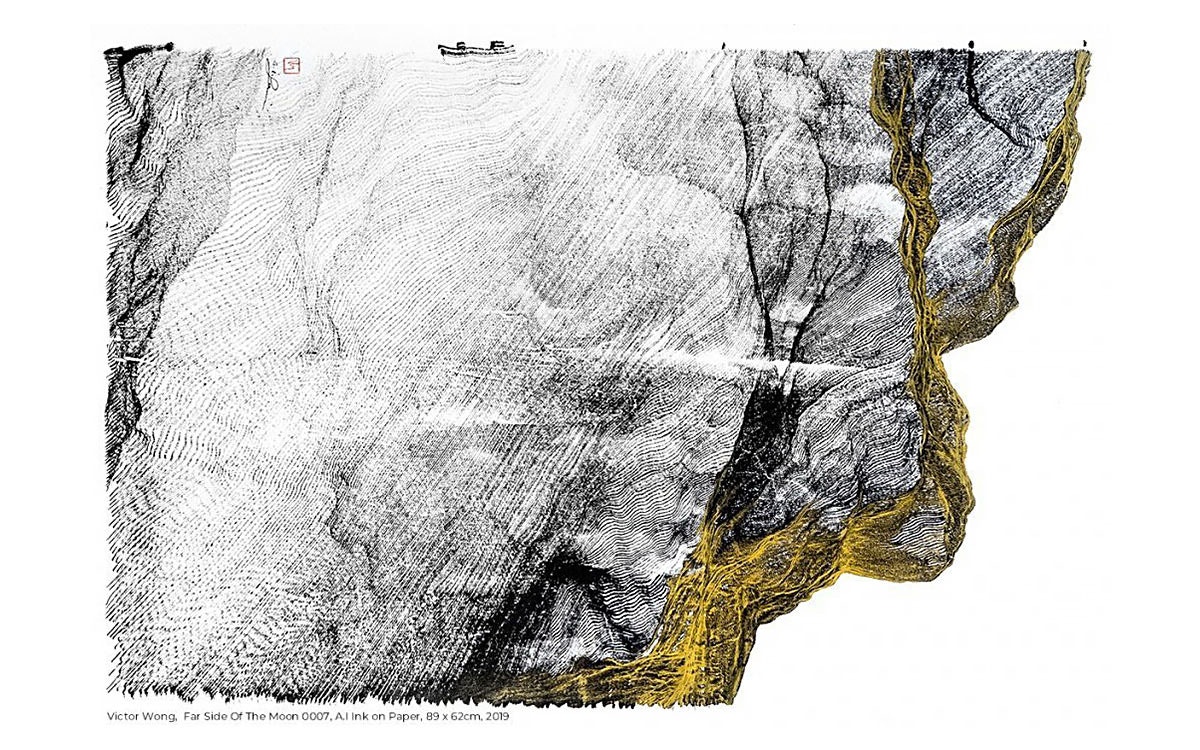
Far Side of the Moon by Victor Wong x A.I. Gemini - 3812 London Gallery
This Spring, 3812 London Gallery hosts new work by innovative artist and inventor Victor Wong, who is leading the collaboration between artificial intelligence and ink art.
This Spring, 3812 London Gallery hosts new work by innovative artist and inventor Victor Wong, who is leading the collaboration between artificial intelligence and ink art. Wong is the creator of A.I. Gemini, the world’s first robotic ink artist programmed with artificial intelligence to paint unique Chinese landscapes. Gemini is coded to plot 3D virtual terrain. Gemini’s arm dips its brush into ink and water, sweeping across fresh xuan paper with calculated choreography to reproduce this terrain with lines and shading. Each resulting work is unique. Wong’s experimentation with A.I. was driven by his desire to explore the possibilities of combining technology and art. He says that ‘my challenge is to make A.I. more human. My collaboration with Gemini is an extension of my art.’ Although other artists are also harnessing the potential of artificial intelligence, Gemini does not utilise an ink jet printer, but uses the ancient art of ink and water painting – shui-mo. Traditional Chinese ink painting in this style takes skilled artists decades of training to master the same level of brush control that Gemini is capable of, but Gemini has taken Wong just three years to build and programme. Calvin Hui, co-founder of 3812 Gallery says: ‘Victor Wong’s work with A.I. Gemini defines a new movement in ink art – Tech Ink. It is disrupting the art world and Chinese ink; expanding the possibilities technology can offer creativity whilst mindfully exploring the challenges of this relationship.’ The works from the Far Side of the Moon series (2019) are inspired by the ground-breaking contact with the unexplored side of the Moon in early 2019. On the 3rd January, China’s Chang’e-4 probe landed on the distant hemisphere, becoming the first space mission to explore this mysterious region. Gathering exploration data will allow scientists to understand Earth’s Moon, so images of the lunar topography transmitted by Chang’e-4 is the first crucial step towards learning more about our place in the cosmos. Wong harnesses this feeling of innovation in the Far Side of the Moon series. Fed with the Chang’e-4 images and 3D observation data from NASA, Gemini has analysed and interpreted these in its own style to create unique lunar landscapes. Chaotic trails of deep, fine lines trace across silky paper, the images reverberating with rocky crags; not dissimilar to our own topography. Wong says, ‘just as the Chang’e-4 mission has reawakened international interest in our Moon’s mysteries, I hope my work’s response to this scientific advancement will rekindle interest in Chinese ink painting for the 21st century.’ The exhibition’s theme of reinventing past artistic traditions is continued in Wong’s Escapism series (2018). Escapism experiments with Chinese brush and ink painting; establishing a space for traditional Eastern aesthetics in the modern world. These ink landscapes are painted in the tradition of Xieyi (寫意/意境). Xieyi is an expression of spirit within the lines of the image, rather than a direct recreation of reality. In traditional Xieyi works, grand mountainous landscapes capture the majesty of nature; an emotional reminder of the insignificance of observer. In Escapism, Gemini also plots unique fictionalised landscapes. But the creation of art with A.I also subverts this traditional art form, posing pertinent questions about the ability of technology to internalise complex ideas. Gemini’s work pushes us to think about the potential of technology, asking if machines are capable of understanding the underlying emotions in art. This sets up a curious exchange between technology and artist. Is Gemini a tool of Wong’s artistry, or is Wong’s technology capable of individualistic production? Wong sees his work with Gemini as a collaboration between man and machine. Wong has treated it as a student, coaching it to master simple brush strokes and programming it to develop its own recognisable style rather than copy the work of ink masters. He believes that the artificial intelligence governing it is indeed advanced enough to parallel aesthetic judgement. Gemini has proved a capable student, as careful algorithms and random factors allow it to create beautiful compositions without assistance. Gemini’s decisions have become autonomous, and the form of its chaotic and wild landscapes are now unpredictable even to Wong himself. Perhaps then, Gemini can (within the confines of its algorithms) be said to exercise its artistic imagination in the creation of these artworks. With machines capable of this level of individual production, Far Side of the Moon opens an intriguing discourse to the future of technology in artistic practise, asking if artificial intelligence has the potential to become an autonomous artist itself; breaking out of the confines of its human programmers.